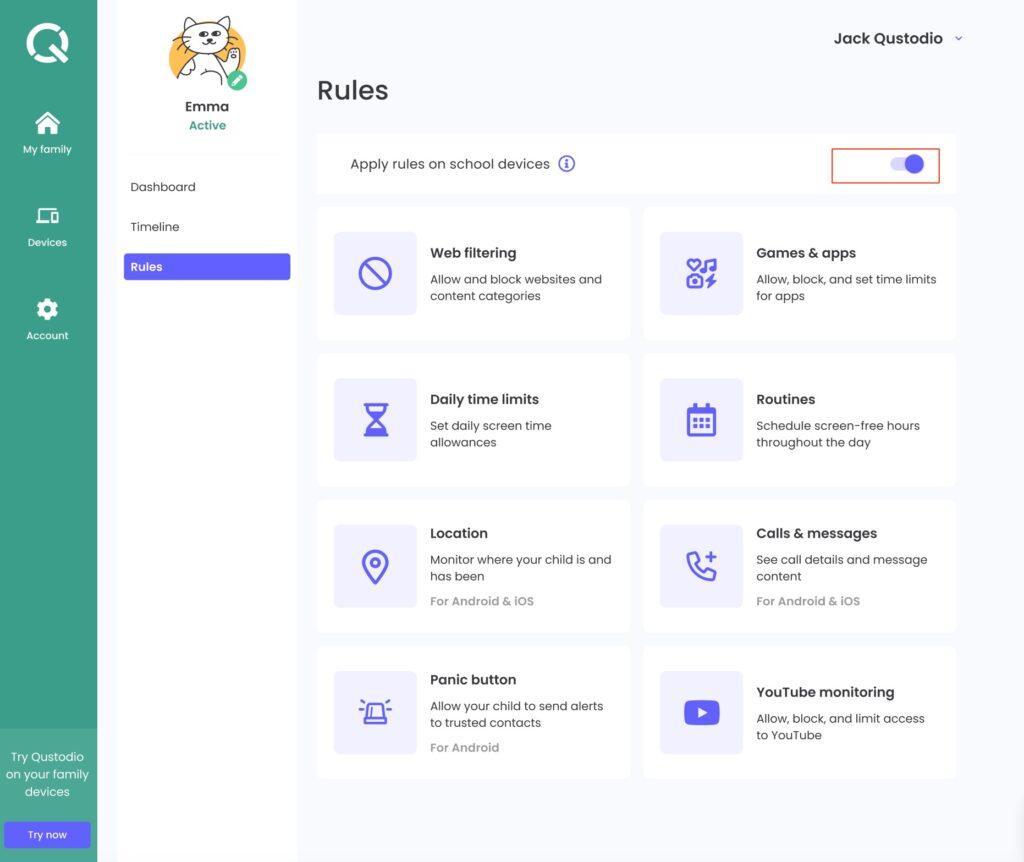
When comparing Qustodio and Bark, two leading parental control software options, it’s crucial to delve into their technical capabilities, unique features, and how they cater to the needs of parents looking to safeguard their children’s digital experiences. Both platforms offer a suite of tools designed to monitor, manage, and protect online activities, yet they approach these objectives with different methodologies and feature sets.
Features
Qustodio is renowned for its comprehensive activity monitoring and time management features. It excels in providing detailed reports of online activity, including the time spent on specific applications and websites. This granularity extends to the ability to block unwanted content and set time limits on device usage, making it a powerful tool for parents who wish to closely supervise their children’s digital habits. The software supports multiple platforms, including Windows, macOS, Android, iOS, and Kindle, ensuring coverage across most devices used by children today. Qustodio includes a location tracking feature, allowing parents to know their child’s whereabouts, which adds a layer of physical safety on top of online security.
Try Qustodio Today
Get Started for less than $5 per month
Bark, on the other hand, focuses heavily on monitoring communications and social media interactions to detect potential threats such as cyberbullying, online predators, sexting, and depression. What sets Bark apart is its sophisticated algorithm that analyzes texts, emails, and social media posts and messages for signs of dangerous interactions or content. Rather than blocking content outright, Bark alerts parents to potentially concerning behavior, facilitating open conversations about online safety and mental health. This approach is particularly valuable for parents of older children and teenagers who require more privacy but still need oversight. Bark supports most major social media platforms, email providers, and texting apps, making it highly effective in the digital environments where teens spend most of their time.
Customizations
Both platforms offer customization options, allowing parents to adjust settings according to their child’s age, maturity level, and specific family values. Qustodio focuses primarily on its control and intervention capabilities, while Bark emphasizes awareness and dialogue.

Technology
Qustodio and Bark leverage advanced data analysis and machine learning algorithms to categorize content and identify risks. Qustodio’s system is highly effective in filtering and blocking inappropriate content based on categories and predefined lists. It uses a combination of URL tracking, keyword detection, and browsing history analysis to enforce web filters and time controls.
Bark’s technology, meanwhile, is designed to understand the nuances of human communication. It uses natural language processing (NLP) and machine learning to sift through vast amounts of text and image data, looking for patterns and signals that indicate harmful interactions or emotional distress. This advanced detection capability allows Bark to provide timely alerts on a wide range of issues, from cyberbullying to potential mental health concerns, without requiring parents to manually review every piece of communication.

Ease of Use
For parents concerned about setup and usability, Qustodio and Bark both offer user-friendly interfaces and straightforward setup processes. The complexity of managing and configuring the multitude of settings in Qustodio may be more daunting for less tech-savvy individuals compared to Bark’s more automated, alert-based system.

Final Word
For those prioritizing comprehensive monitoring and direct control over device usage and content access, Qustodio offers a robust solution. Conversely, Bark’s strength lies in its ability to foster open dialogues about online safety and mental health through its monitoring of communications and social media, making it ideal for families with teenagers seeking a balance between oversight and independence. Both platforms embody a commitment to child safety in the digital age, albeit through distinct approaches that cater to varying parental preferences and concerns.
Comparison Table
| Feature | Qustodio | Bark |
|---|---|---|
| Core Focus | Activity monitoring, content blocking, time management | Monitoring communications, detecting potential threats |
| Platform Support | Windows, macOS, Android, iOS, Kindle | Most major social media platforms, email, texting apps |
| Content Monitoring | Detailed reports on app and web usage, content blocking | Analysis of texts, emails, and social media for harmful content |
| Time Management | Extensive time limits and scheduling features | Limited, focuses more on content monitoring |
| Location Tracking | Yes | Yes |
| Alerts & Reporting | Activity reports, real-time alerts for blocked content | Alerts for concerning behavior, potential risks |
| Technology | URL tracking, keyword detection, browsing history analysis | Natural language processing, machine learning for pattern detection |
| User Interface | User-friendly, but complex settings | User-friendly, automated alerts |